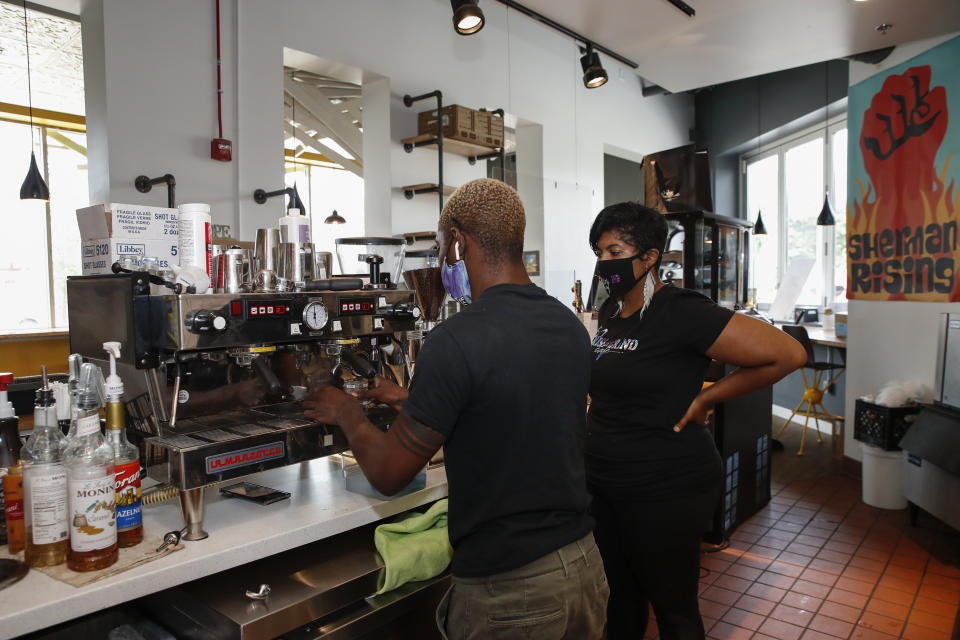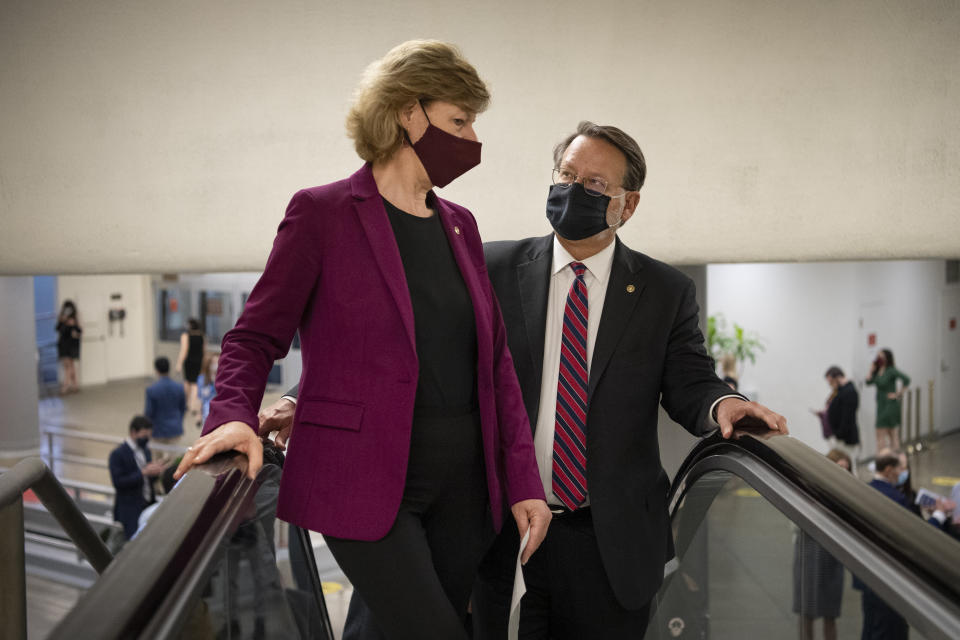Restaurants Brace For Federal Aid To Run Dry Before They Get Help
- Oops!Something went wrong.Please try again later.
MILWAUKEE, Wis. — The American Rescue Plan included a $28.6 billion lifeline for restaurants, but business owners are already worried the money will run out before they get any aid.
Bounce Milwaukee is one of those businesses. In 2014, Becky Cooper-Clancy opened a party space with laser tag, rock climbing, ax throwing, arcades, bounce houses and a restaurant and bar. Think Chuck E. Cheese, but locally owned, with a community justice mission and fun for kids and adults alike.
In 2019, the business made more than $1 million. Last year, by attempting a takeout pizza and parking lot drive-in movie business, it barely scraped together $200,000. It has been fully shut down since August, volunteering its building to a mutual aid organization.
Cooper-Clancy was able to get around $150,000 from the Paycheck Protection Program, and she took out an Economic Injury Disaster Relief Loan. She and her husband stopped paying for their personal medical insurance just to save a couple hundred dollars per month. The bank account has run dry and she has twice the debt she had when she opened the business.
The day the Restaurant Revitalization Fund launched last week, Cooper-Clancy found herself refreshing the Small Business Administration website page to submit her application.
“If we are approved for the Restaurant Revitalization Fund I think we will be OK and we will make it through. If we don’t get that, because it’s really underfunded, I think we have just delayed the inevitable,” Cooper-Clancy said. “It’s been weird to have to come to terms with the idea of closing up the business and giving up on this baby that we’ve nurtured for nearly seven years. Coming to terms with that and then having this new burst of maybe it will work out after all has been a huge roller coaster.”
The Restaurant Revitalization Fund ― part of the American Rescue Plan signed into law by President Joe Biden in March ― restores restaurants’ lost revenue during the pandemic up to $10 million (or $5 million per physical location). As long as businesses use the money before 2023, they don’t have to pay it back. Women- and minority-owned businesses are prioritized for the funds in the first 21 days.
Within the first three days, the Biden administration announced that the program had received more than 180,000 applications. By this week, the SBA had approved more than 16,000 businesses for funds.
Already, restaurants are warning it’s not enough money. And the administration seems aware that demand is bigger than the fund itself.
If we are approved for the Restaurant Revitalization Fund I think we will be OK and we will make it through. If we don’t get that, because it’s really underfunded, I think we have just delayed the inevitable. Becky Cooper-Clancy, Milwaukee business owner
In a webinar with the U.S. Black Chambers about the money, Patrick Kelley, who runs the SBA’s Office of Capital Access, made clear that there “is probably not going to be enough funds, in all likelihood, for the demand that’s out there.”
“Please apply so we can send a strong statement to Congress and the administration that there is demand and hopefully we will act as a country as we did over the last year to provide additional funds,” Kelley told the participants.
The fund was designed to course-correct after the messy rollout of the Paycheck Protection Program, the forgivable business loans passed under the CARES Act last year. The government has given out more than $780 billion under the PPP program to date; the latest extension of the program under Biden has already run out of money.
Small businesses, and restaurant owners in particular, are quick to say that the PPP program was flawed. The quick rollout left many banks in the dark, unable to help clients. The rules around the loans kept changing. And many businesses couldn’t access the program, disproportionately leaving minority- and women-owned businesses to fall through the cracks. Large corporations and businesses received the majority of the funding.
Even those who were able to get PPP money say it was a slog.
“We just needed direct aid much sooner and it was really difficult to stay afloat in that way and have so much uncertainty and chaos,” Cooper-Clancy said. “The first PPP loan, I think I spent three or four full days trying to get the information I needed and get it through our bank, and no one had any answers.”
Part of the battle now is ensuring restaurant owners know a new fund is available.
A.J. Dixon, chef and owner of Milwaukee restaurant Lazy Susan MKE, has taken it upon herself to educate business owners around her, hosting webinars on the Restaurant Revitalization Fund for women- and Black-owned businesses.
Before Wisconsin had stay-at-home orders, Dixon told her employees to start applying for unemployment insurance just to get into the system early in case she’d have to shut down. Now her message to Congress is that this can’t be the last lifeline. And, she said, because relief came so late, restaurants are digging out of a bigger hole than expected.

“This is going to be a slow process,” Dixon said. “It’s not a matter of just everywhere opens doors again and everything is going to be OK. There’s still going to be people who are hesitant to go out, and that is affecting the economy.”
“A lot of this industry lives paycheck to paycheck. The amount of disregard to help us sooner was bullshit, and that’s on every party’s count,” Dixon said. “There’s no reason why this should have taken that long.”
The Restaurant Revitalization Fund has been popular with both Republicans and Democrats ― even though every single Republican in Congress voted against the rescue package that included the money. That inconvenient fact hasn’t stopped Republicans from touting it and encouraging their constituents to apply, allowing them to look like they are helping restaurants in their districts get much-needed funds.
But the urgency of passing more COVID-19 relief has disappeared in Congress. Democrats are laser-focused on the president’s infrastructure proposal. Meanwhile, Republicans have been advocating to cut off additional federal unemployment insurance. There’s been little bipartisan appetite to add more money to the PPP program, which has already run dry, let alone consider additional targeted relief down the road.
A lot of this industry lives paycheck to paycheck. The amount of disregard to help us sooner was bullshit, and that’s on every party’s count. A.J. Dixon, Milwaukee Restaurant Owner
It’s a reality that scares restaurant owners who are hopeful but realistic that this summer won’t bring them the same revenue as past years. Running a business is more expensive now, said Melissa Buchholz, co-owner of Milwaukee restaurant Odd Duck.
“Restaurants, a lot of us, lose money in the winter, and we depend on the summer to get us through the winter,” Buchholz said. “Well, this summer, it’s going to be better than before, but it’s going to be like an old winter. So if operating at full capacity is our slowest month, it’s hard to imagine a way the business survives with double the debt.
Costs are going up, she said. Food is more expensive, transportation costs have gone up and supply chain disruptions have increased her costs across the board. Buchholz, who owns 50% of the business will have to wait out the first 21 days of the Restaurant Revitalization Fund until she’s eligible for funds. This week, she opened her restaurant to indoor dining for the first time during the pandemic.
There’s a tangible sense of exhaustion. She, like many other small business owners, has been reinventing the wheel for the past 14 months to keep business afloat and as many workers employed as possible. She’s done takeout, take-home party boxes and farmers market baskets.
“I’m paying for a whole retraining of a staff that I normally wouldn’t have to do. Those are huge costs,” Buchholz said. “Restaurants typically only make single-digit profit margins.”

Sen. Tammy Baldwin (D-Wis.), who spent the weekend touring Madison, Wisconsin, restaurants trying to stay open during the pandemic, wouldn’t commit to supporting additional funds for the program in any of the upcoming bills, but said she was monitoring progress.
“It’s unclear what legislation bill will be used to continue to look at small business assistance,” Baldwin said, adding that she hopes some state and local funding can also be directed toward small business relief. “The record shows we have adapted and adapted and added more funds, and [adding more funds] is certainly a possibility.”
For now, restaurants just have to wait and see if they make the cut.
“It feels like a crapshoot,” said Caleb Nicholes, co-owner of a Madison coffee shop.
This article originally appeared on HuffPost and has been updated.


